
1 NORWEGIAN HARBOUR 2002 – 07 480 x 582
THERE AND HERE Folio 3
Oil Paintings of Australia, New Zealand and back in Britain
HILDA MARGERY CLARKE
a follow-up to the 2004
show Here and There
(being the Northern half of her
round-the-world trip)
Sat 29 March – Sat 12 April 2008 now Extended to 20 April
 1 NORWEGIAN HARBOUR 2002 – 07 480 x 582 |
Loosely based on Oslo, where the big yellow building is a tourist information centre. My drawing, done on the spot, shows that the building here is nothing like the original; also, scores of bicycles were chained to the harbour rails, but somehow did not make it into the picture, either — however, that's the process of painting! |
| This is an accurate rendering of Mount Conner, an extraordinary rectangular block rearing up out of a flat plain. It is in the same area, and clearly the same geology, as Uluru, for which it is often mistaken by travellers. Although the latter is so famous there are other formations, including another one much further south, a long way from Adelaide. It is little known and so far into the outback that I was unable to get to it. |
 5 AUSTRALIAN MONOLITH 2005 312 x 510 |
It was heartening to see the number of young men skilfully working in this event at Suffolk County Show, Ipswich. From all the goings-on there, it was clear that young people are still maintaining old traditions. |
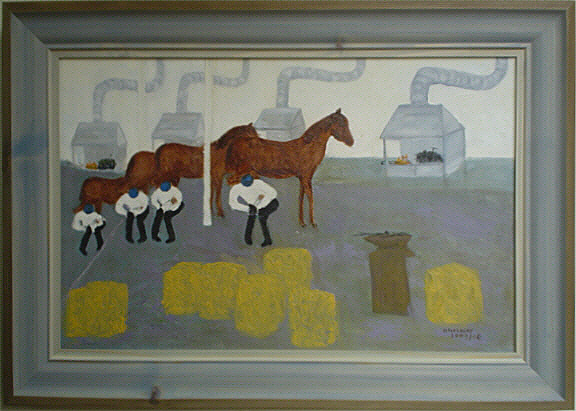 14 HORSE-SHOEING COMPETITION, SUFFOLK I 2007 – 08 371 x 584 |
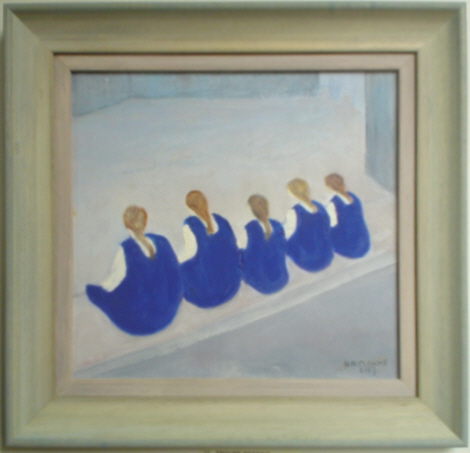 15 TROUPE RESTING, ALICE SPRINGS I 2007 315 x 337 | Since photgraphing this, I've altered one of the girls' hair-colour, for variation These girls were watching an acrobat performing in the road, part of the entertainment in which they were involved as dancers. This all seemed to be impromptu, with no charge, though a hat may have been passed round. The main street is full of traffic during the week, but not on Sundays when there are stalls along the sides of the road, selling all kinds of things and lots of crafts. With so much space, most Australian outlying towns have wide streets built on a grid.
Alice Springs is famous as the first Antipodean telegraph station. Because of a range of hills blocking the way, donkeys were used go round them to deliver messages to the station on the othe side, which linked with Darwin. Eventually Simpson's Gap was discovered: for the first time, Australia was able to communicate with the outside world. The Telegraph Station is now a tourist attraction. |
The mine is now a tourist attraction. You 'pays yer money', don a blue helmet and stand in the queue to await your turn to enter the yellow cabins and descend into the bowels of the earth. Even this commercialism cannot destroy the atmosphere, with its inhospitable bleakness and jagged scattered slate dominating everything. Conditions in its industrial heyday must have been harsh. Even now the impression is chillingly desolate. |
 18 SLATE-MINE, BLAENAU FFESTINIOG 2006 – 07 241 x 409 |
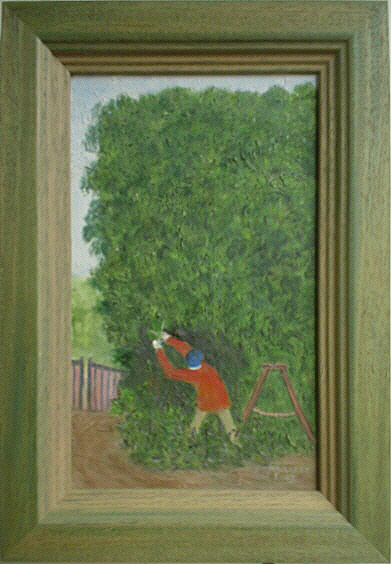 29 HEDGE CUTTER 2007 285 x 173 • Developed from a glimpse of a man seen on the way to Suffolk. |
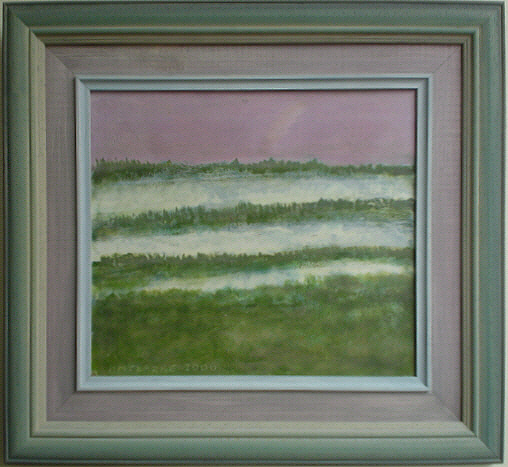 31 NEW FOREST MISTS 2007 213 x 241 This strange effect occurred on the way home through the Forest very late one autumn afternoon, and is not imaginary. A friend, who has known the Forest well for almost 50 years, remarked that he'd never observed the phenomenon. |
This is not an accurate depiction: the tunnel is much lower, but the eeriness is correct. Troughs are placed on the ground at intervals where the tar seeps through the walls. It is very wet and we were only able to go part way because water stretched from side to side. | 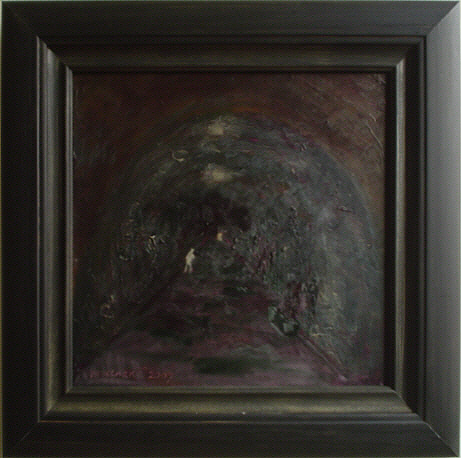 30 TAR TUNNEL, IRONBRIDGE 2007 282 x 285 |
 32 HIDDEN CREATURE 2004 255 x 345 • |
exh. in "Into the Jungle: Homage to Rousseau", John Martin Chelsea, Dec. 2005 We must have all heard of bushfires and probably know that some trees require the fires to germinate their seeds. They arise spontaneously: the flames travel at great speed but are not the same as the huge headline-grabbing ones which are dangerously out of control. Native peoples were in tune with the land and would start fires for this regeneration at the appropriate time. It used to be done by the colonials as well, but with less understanding. There are large tracts of land with dramatically stark blackened stumps between those areas where the vegetation is still growing. |
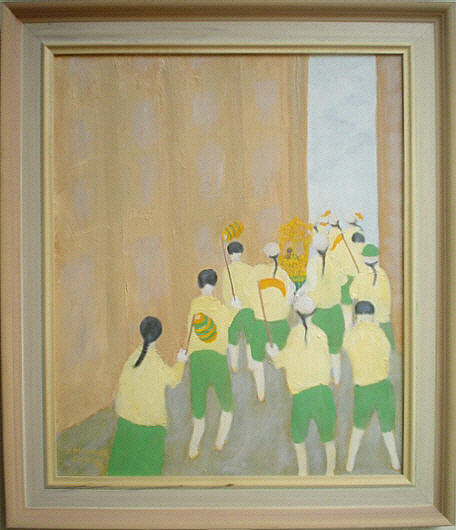 43 BUDDHIST PROCESSION, MELBOURNE 2006-08 503 x 415 • |
 45 AUSTRALIAN CREEK 2007 156 x 164 A composite from the creeks and gullies in the Red Centre (around Uluru). |
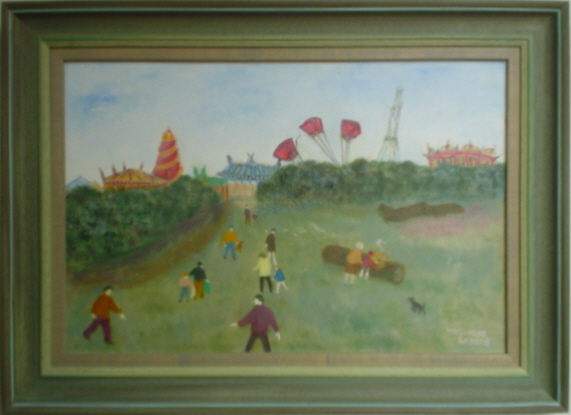 47 SOUTHAMPTON COMMON FAIR 2007 – 08 369 x 559 • |
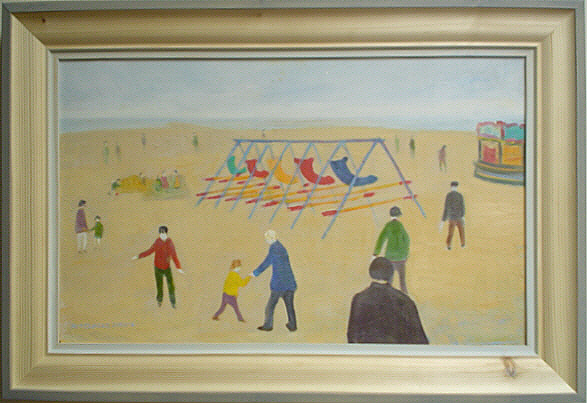 49 SWINGBOATS AT REST, RAMSGATE 2002 – 07 352 x 589 |
At the end of the day, the boats are hung up to rest and the people disperse. Very unusually for me, this painting was done from a drawing, made late in the evening, when the beach was not full of figures, as here. |
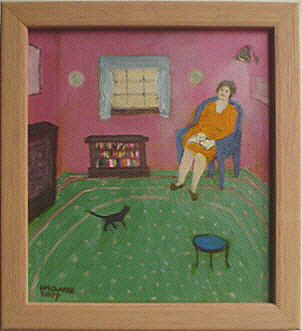 51 THE INTERRUPTED READ 2006 – 07 195 x 172 Interpreted recall of a visit to a friend in Surrey. |
 40 TO THE BEACH 2004 – 08 140 x 105 'Lifted' from a detail in The Blue Café, exh. in "Here and There" (2004) |
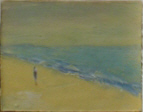 41 SEA WATCHER I 2008 80 x 102 All this series sold. HMC plans to do a few more along these lines |
 52 "THE ARTIST'S PALETTE", WAI-O-TAPU, N.Z. 2007 – 08 520 x 616 |
This geothermal area, with its geysers and boiling mud, is famous worldwide. Rotorua, at its centre, is extraordinary but over-touristed, with the famous “Prince of Wales Feather” Geyser. This can shoot up to 10m. (30') high on good days. A few miles away, boasting New Zealand's largest lake, is the town of Taupo, less blatantly commercialised. Nearby, the vast expanse of Wai-O-Tapu is like another world. This image is loosely based on the orange-fringed, green “Champagne Lake”, so named because of its small sparkling bubbles. The colours in the rest of the area, pink, pale blue and yellow, change over the days and seem to shimmer in the air above. It would have delighted Monet! The walkway is to enable people to proceed over the unstable surface, going across the "Palette" and right round close to the edge of the circular lake. Full of chemicals, some precious, some lethal, it is a silent world, apart from odd rumbling in the craters: a reminder of the instability of our planet and the unfathomably immense forces which created it. To a lesser extent these forces are evident around the whole of this stretch of the island: there is always the smell of sulphur, and puffs of steam unexpectedly appear just about anywhere. Mephistopheles cannot be far away! See http://www.geyserland.co.nz/vtours.htm for visual tours of these wonders |
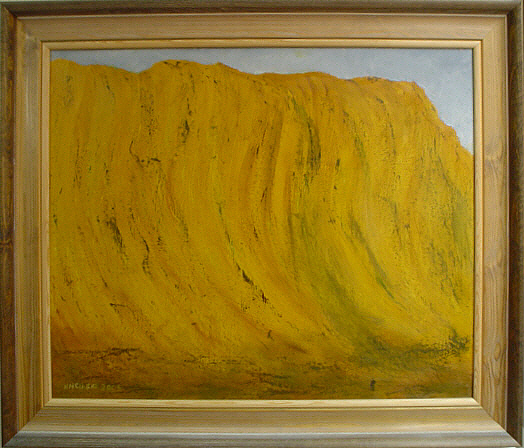 53 WAVE ROCK, W. AUSTRALIA 2006 585 x 705 Situated several hours journey from Perth in the south-western corner of the continent, this amazing natural formation is enormous (24m. / 75' high). The top of it is absolutely flat and can be reached by climbing up a track. |